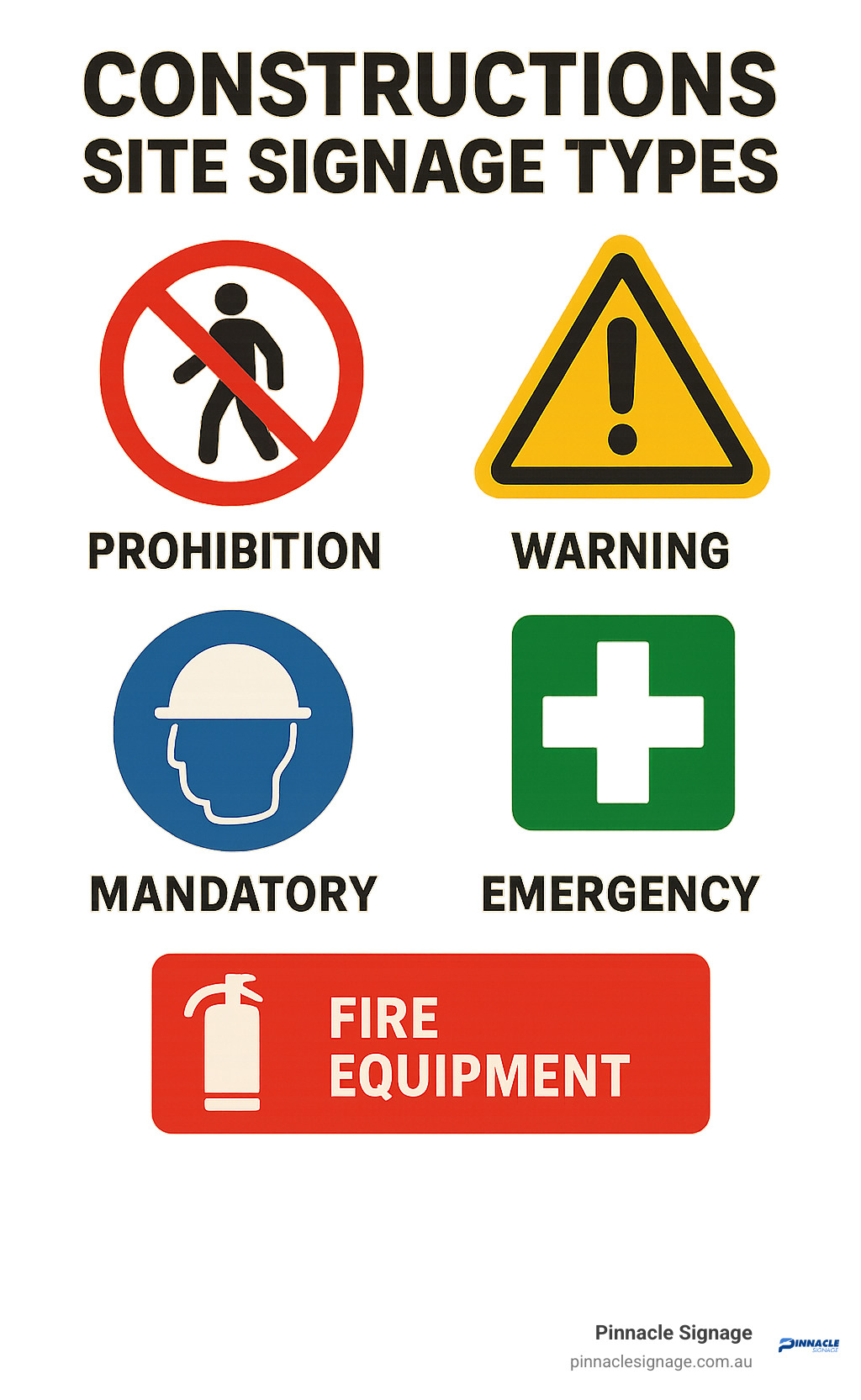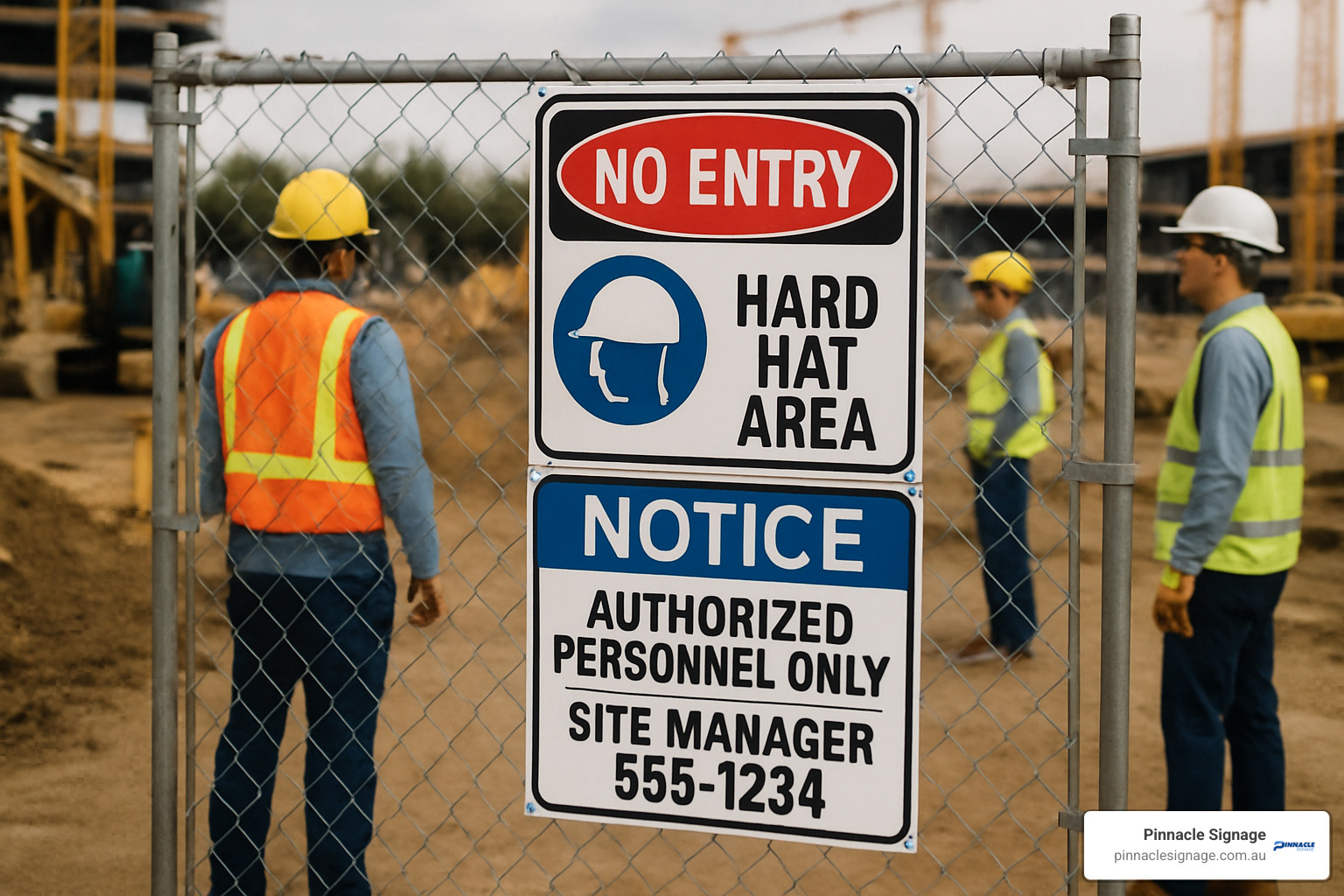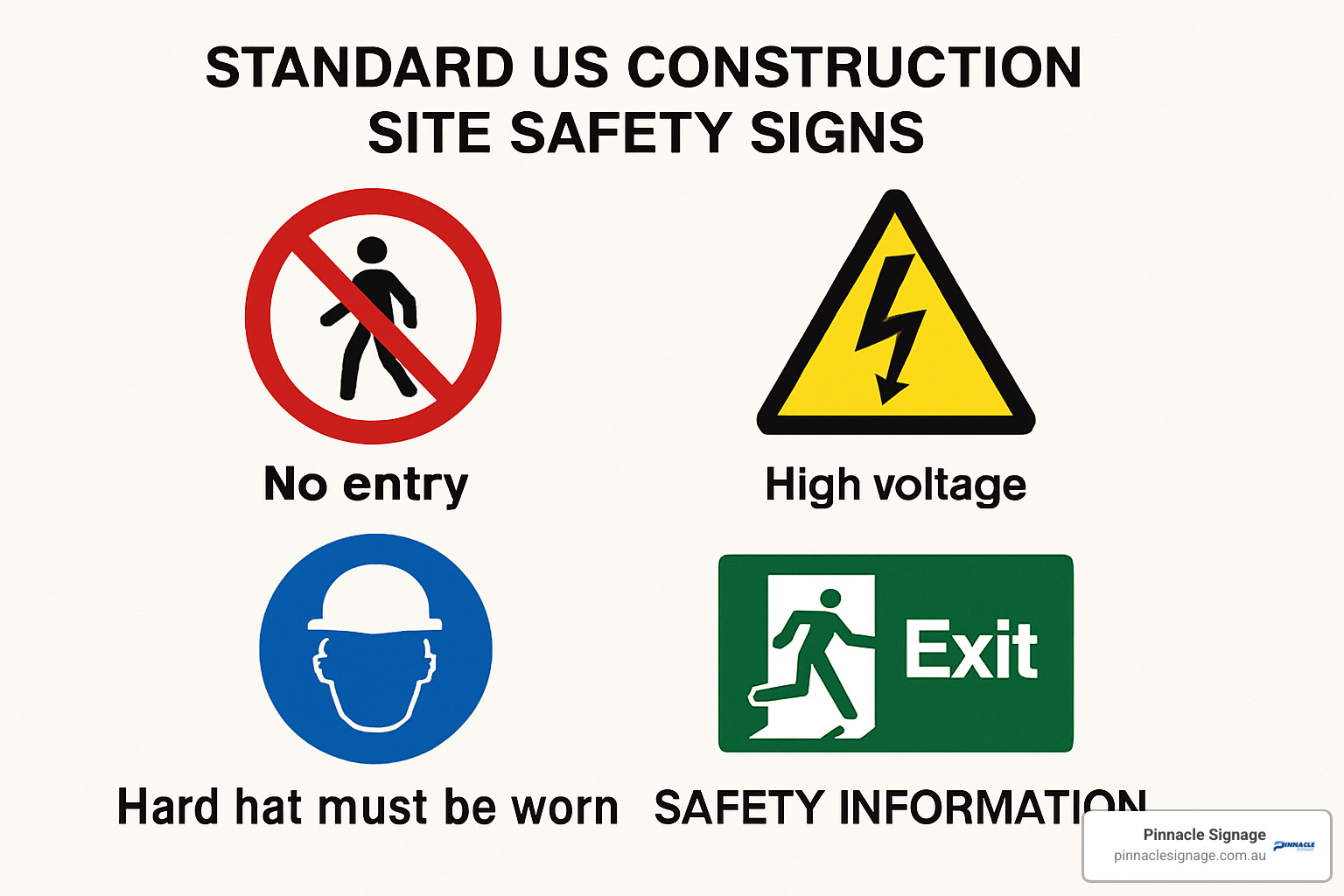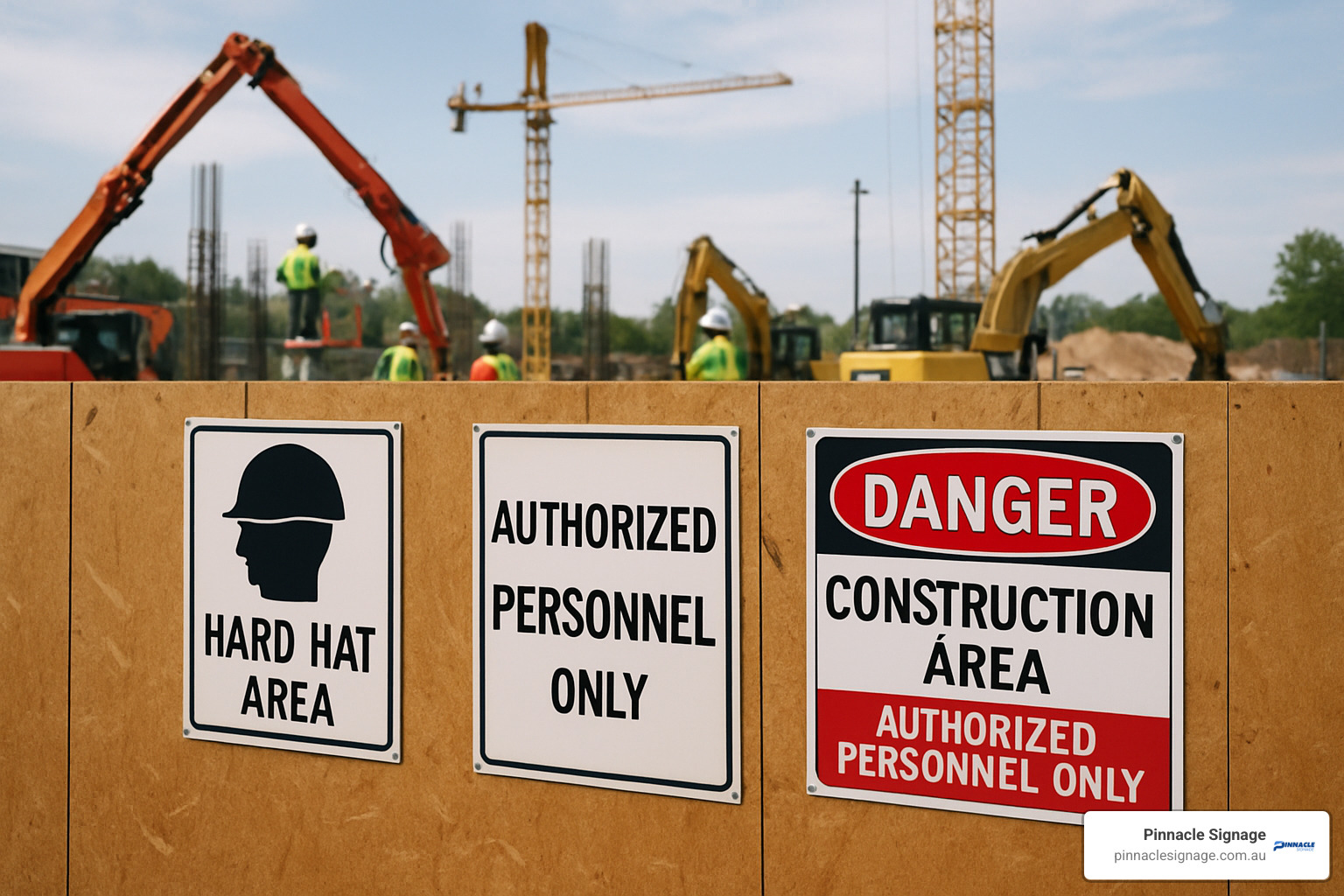
Everything You Need to Know About Construction Site Signage
Construction Site Signage: Essential Requirements for Safety and Compliance
Construction site signage is required by law on all Australian building sites to communicate hazards, safety protocols and site information. Here's what you need to know:
- Mandatory signs: Site entry warnings, PPE requirements, emergency information
- Warning signs: Yellow triangular signs indicating specific hazards
- Prohibition signs: Red circular signs with crossbars showing prohibited actions
- Mandatory action signs: Blue circular signs indicating required behaviours
- Emergency/information signs: Green rectangular signs showing exits and first aid
Construction sites are inherently dangerous environments with constantly changing hazards. Without proper signage, workers, visitors and the public are at significant risk of injury or worse. Beyond the obvious safety concerns, inadequate signage can lead to serious legal consequences, including fines, project shutdowns and liability for injuries.
Effective construction site signage serves multiple critical functions. It alerts workers to potential dangers, guides behaviour in hazardous areas, directs emergency responses and helps maintain compliance with Work Health and Safety regulations. When properly implemented, a comprehensive signage system becomes an essential component of site safety management.
I'm Doug Lindqvist, General Manager of Pinnacle Signage, with extensive experience providing compliant construction site signage to projects across Australia, helping site managers meet their safety obligations while ensuring clear communication of hazards and protocols.

Simple construction site signage word guide:
Construction Site Signage: Definition & Importance
Let's get real about construction site signage - those essential visual communications that do much more than just decorate your building site.
Think of construction site signage as your site's silent safety team. They are constantly communicating critical information when you can't be everywhere at once. From warning about live electrical hazards to reminding workers about mandatory hard hats, good signage creates a safer environment for everyone.
The importance of proper signage goes well beyond just ticking compliance boxes. When you install comprehensive construction site signage, you're addressing several crucial needs at once:
First, you're clearly communicating specific hazards in each area of your site - whether it's falling objects, trip hazards or dangerous equipment. This awareness dramatically reduces accident risks.
You're also fulfilling your duty of care as a site manager or business owner. By taking reasonable steps to inform and protect workers and visitors, you're demonstrating responsible site management.
The statistics tell the story - according to Safe Work Australia, construction accounts for about 20% of workplace fatalities despite employing only around 9% of Australian workers. Proper construction site signage is a proven factor in bringing those numbers down.
There's also the legal side - meeting Work Health and Safety requirements isn't optional. The right signage helps you avoid penalties that could seriously impact your project and business.
Don't forget public protection either. Your signage warns pedestrians and motorists about construction hazards, preventing accidents and potential liability issues.
And finally, there's the efficiency factor - good signage directs traffic flow and activities to maintain productivity, saving you time and money.
The Role of Construction Site Signage in Modern Projects
Today's construction projects are more complex than ever. Multiple contractors often work in shared spaces, creating a challenging safety environment. This is where construction site signage becomes even more valuable.
In the risk management hierarchy, signage falls under administrative controls:
- Elimination of hazards (most effective)
- Substitution of hazards
- Engineering controls
- Administrative controls (including signage)
- Personal protective equipment (least effective)
While signage isn't at the top of this hierarchy, it serves as a constant visual reminder of hazards that simply can't be eliminated entirely. This translates directly to cost savings - considering the average workplace injury claim in Australia costs approximately $11,500, not counting indirect costs like project delays and replacement labour.
A thoughtfully designed construction site signage system creates an environment where safety becomes second nature. Workers receive constant reminders of required protocols, visitors can steer safely without extensive briefings and emergency information is readily available when seconds count.
For site managers, comprehensive signage also provides tangible evidence of compliance with WHS obligations - something that becomes critically important if incidents do occur.
At Pinnacle Signage, we understand that effective construction site signage isn't just about compliance - it's about creating a culture of safety that protects your team, your project and your business.
Legal Requirements & Compliance Standards for Australian Sites
Navigating the regulatory landscape for construction site signage in Australia does not have to give you a headache. Several key frameworks govern what signs you need and how they should appear:
The Work Health and Safety Act 2011 lays the foundation with its duty of care requirements. This is not just legal jargon - it's about making sure everyone goes home safely at the end of the day. Safe Work Australia Codes of Practice then build on this foundation with practical guidance that turns legal requirements into actionable steps.
For the nitty-gritty details, Australian Standard AS 1319 is your guide. It specifies exactly what your safety signs should look like, from colours to symbols. Also check your state-specific regulations - requirements can vary depending on whether you're breaking ground in Queensland or Victoria.

As the Person Conducting a Business or Undertaking (PCBU), you're responsible for ensuring safety signs appear wherever hazards cannot be eliminated or adequately controlled through other means. Penalties for non-compliance range from on-the-spot fines that sting your wallet to court-imposed penalties that could seriously impact your business.
The good news? Compliance is straightforward. Your construction site signage must include clear contact information for site managers at all entry points. Signs need to follow Australian Standard specifications for colours, shapes and symbols - no creative interpretation here. They must be visible and legible from the intended viewing distance, and they must be maintained in good condition throughout your project.
For more technical details on compliance standards, check out this research on safety sign regulations.
Mandatory Signs You Must Display
Every Australian construction site needs certain non-negotiable signs:
- Site entry warnings create a clear boundary between your construction zone and the public.
- Personal Protective Equipment (PPE) requirements remind everyone what safety gear they need before stepping on site.
- Emergency information signage could literally save lives by showing evacuation routes, assembly points and first aid locations.
- Specific hazard warnings identify dangers unique to your site.
- Fire safety information marks equipment locations and exits.
Some sites need extra mandatory signage based on specific hazards - for example asbestos, high voltage or confined spaces.
How to Determine Which Signs Your Site Needs
Creating your site's signage plan is not guesswork. Follow a methodical approach:
- Conduct a thorough risk assessment to identify all potential hazards.
- Create a hazard register documenting each hazard, its location and required control measures.
- Consult Australian Standards for specific signage requirements.
- Have a competent person review your plan to spot any gaps.
- Update signage as the project evolves - excavation, structural work and finishing stages often need different signs.
At Pinnacle Signage we can help identify the precise construction site signage requirements for your project, ensuring compliance without unnecessary complexity.
Decoding Sign Types, Colours & Shapes
When you walk onto a construction site, you're immediately surrounded by a visual language designed to keep you safe. This is not random - construction site signage follows a carefully designed system that communicates instantly through colours and shapes.
Think of it as a universal safety language that speaks to everyone, regardless of their reading ability or native tongue. The moment you spot a red circular sign with a diagonal line, your brain immediately registers "don't do this" before you consciously process the specific symbol.
Colour Coding System
The colours used in construction site signage are not chosen for decoration - each serves a specific purpose:
- Red signs demand immediate attention, signalling either "stop/don't do this" (prohibition) or marking fire equipment locations.
- Yellow is nature's warning colour, making it perfect for caution signs that alert you to potential hazards.
- Blue signs are your "must-do" instructions - they indicate mandatory actions like wearing hard hats or safety glasses.
- Green signals safety information - it's calming and indicates emergency exits, first aid stations and safe assembly points.
- White signs typically contain general information that is helpful but not directly safety-related, such as site office locations.
Shape Coding System
The shape of a sign works alongside its colour to reinforce the message:
- Circles with diagonal crossbars (red and white) show prohibited actions.
- Plain circles (blue and white) indicate mandatory actions.
- Triangles (yellow and black) warn you about specific hazards.
- Squares or rectangles (green or blue) provide information, directions or mark safe conditions.

Size matters too. Signs need to be visible from a distance that gives workers enough time to recognise and respond to the hazard. A small electrical hazard sign tucked away in a corner simply will not do the job when lives are at stake. For a deeper dive into specific warning signs, check out our guide on caution signs you can't miss on a construction site.
Reading Construction Site Signage at a Glance
The beauty of effective construction site signage is how quickly it communicates crucial information. In an emergency, nobody has time to read paragraphs of text.
Quality signs use consistent pictograms - standardised images that instantly convey meaning without words. These symbols work brilliantly on Australian construction sites where diverse workforces often include people who speak different languages.
Good signs also feature high-contrast colours that remain visible in poor lighting or dusty conditions. Simplified text gets straight to the point with clear, concise messages.
For sites with workers from varied backgrounds, multilingual options can provide additional clarity for critical safety information.
Construction Site Signage Shapes & Their Meanings
- Circular signs with crossbars tell your brain "don't do this".
- Plain circular signs are your "must-do" instructions.
- Triangular signs put your brain on alert mode.
- Square or rectangular signs guide you to safety resources or provide helpful information.
At Pinnacle Signage, we've seen how proper signage prevents accidents and creates safer worksites. The visual language of construction site signage isn't just about ticking compliance boxes - it's about ensuring everyone goes home safely at the end of each day.
Placement, Maintenance & Risk Assessment Best Practices
Having the right construction site signage is only half the battle - where you place those signs and how you maintain them can make all the difference between effective hazard communication and overlooked warnings.
Even the most eye-catching sign becomes useless if it's hidden behind a stack of materials or faded beyond recognition. Here's how to get placement right from day one:
- Entry points - Display safety requirements before anyone steps on site.
- Adjacent to hazards - Place warning signs close to the danger, not ten metres away.
- Eye level - About 1.5-1.8 metres from the ground for maximum visibility.
- Correct size - The further the viewing distance, the larger the sign.
- Adequate lighting - Use reflective options in poorly lit areas.

Also be mindful of how your site evolves. That perfectly placed sign on Monday might be obscured by Wednesday's deliveries. Regular checks ensure your signage remains visible.
For technical requirements, see our guide to understanding Australian Standards for Safety Signs.
Maintaining Construction Site Signage for Long-Term Safety
Australian construction sites can be brutal environments for signage. Between scorching sun, sudden downpours, dust and the occasional bump from equipment, your construction site signage takes a beating.
Set up a maintenance routine that includes:
- Cleaning - Remove dust and mud that obscure messages.
- Fade checks - Replace signs showing UV damage.
- Physical damage inspections - Look for tears, dents or bending.
- Position verification - Ensure signs have not been moved or blocked.
Document all inspections and replacements. A clear paper trail demonstrates ongoing compliance if questions arise.
Risk Assessment & Signage Updates
Construction sites change daily. The hazards present during foundation work differ from those during roofing. Review signage weekly, and add or remove signs as hazards appear or disappear.
Pinnacle Signage offers rapid turnaround on additional or replacement construction site signage, helping you stay compliant throughout your project.
Branding, Materials & Temporary vs Permanent Options
Construction site signage does more than keep your site safe and compliant - it can also tell your project's story. Today's construction sites often blend safety requirements with smart branding opportunities that engage the community and showcase your project.
Think about the last time you walked past a major construction site. You probably noticed large, colourful graphics showing what the finished building would look like, or banners explaining the project's timeline. This is not just decoration - it is strategic communication that turns plain barriers into powerful marketing tools.
Material choice matters:
- Corflute - Lightweight, economical and easy to install for short-term projects.
- Aluminium composite - Better weather resistance for projects spanning several months.
- Solid aluminium - Superior durability for high-profile or lengthy projects.
- Vinyl banners and mesh fence wraps - Flexible solutions that transform site boundaries into branded billboards.
- Reflective finishes - Improve visibility in low light conditions.
Leveraging Signage for Marketing & Community Engagement
Smart developers know construction site signage can shift community sentiment from frustration to excitement. Attractive project renders, clear timeline information and highlighting community benefits all help build local support.
For roadwork projects, choosing the right signs is vital. Our Road Work Alert buying guide offers detailed advice.
Choosing Durable Materials for Australian Conditions
Australia's climate is tough on signage. UV exposure fades standard inks, salt spray corrodes metal and high winds can turn solid banners into sails. Pinnacle Signage manufactures construction site signage with UV-resistant inks, marine-grade coatings and wind-friendly mesh options to ensure your safety messages and branding remain clear for the duration of your project.
Consequences of Inadequate Signage & How to Avoid Them
Cutting corners on construction site signage is a risk no project manager can afford. The consequences extend far beyond a simple slap on the wrist.
- Regulatory penalties - SafeWork inspectors can issue on-the-spot fines or stop-work orders.
- Legal exposure - Courts often view missing signage as evidence of negligence.
- Insurance issues - Non-compliance may void coverage when you need it most.
- Reputation damage - Safety incidents quickly become public, harming future contract opportunities.
How to Avoid Signage-Related Problems
- Conduct thorough risk assessments before work begins.
- Document your signage plan as part of your safety management system.
- Assign responsibility for signage maintenance to specific team members.
- Schedule regular reviews to check for damage, visibility issues or new hazards.
- Maintain photographic records of installed signs for evidence of compliance.
For more information on legal implications, see this research on signage-related accidents.
Step-by-Step Checklist Before You Break Ground
- Complete a site risk assessment.
- Create a detailed signage plan.
- Order compliant signs from a reputable supplier.
- Verify correct installation.
- Brief all workers.
- Document your compliance.
- Schedule ongoing maintenance checks.
Pinnacle Signage offers complete construction site signage packages, making compliance straightforward and hassle-free.
Frequently Asked Questions about Construction Site Signage
What size should construction signs be for clear visibility?
Size matters when it comes to construction site signage. Australian Standard AS 1319 provides guidance:
- Visible from 2 metres - at least 120 mm high
- Visible from 6 metres - at least 360 mm high
- Visible from 12 metres - at least 720 mm high
For text, make letters at least 1/25 of the viewing distance. If workers must read instructions from 10 metres away, letters should be about 40 mm tall.
Can construction site signage be customised to include multiple languages?
Yes. Multilingual construction site signage is often essential for safety on diverse Australian worksites. Universal pictograms help, but critical information - especially emergency procedures - should be available in the languages spoken by your team.
Pinnacle Signage regularly creates multilingual signs, focusing on emergency information, evacuation routes and specific hazard warnings.
How often should signs be inspected and replaced?
External construction site signage typically lasts 1-3 years, depending on materials and exposure. Formal inspections should be carried out:
- Monthly for general condition checks
- After severe weather events
- When project phases introduce new hazards
- Whenever the site layout changes significantly
Replace signs immediately if they are faded, damaged, vandalised or outdated. Regular maintenance ensures everyone on site has the information they need to stay safe.
Conclusion
Construction site signage is not just about ticking regulatory boxes. It creates a safety culture that protects everyone on and around your site. When done right, your signage system becomes an invisible guardian, guiding behaviours and preventing accidents before they happen.
Effective construction site signage communicates hazards clearly, meets Australian Standards, is maintained throughout your project and evolves as your site changes. The result is a safer working environment and reduced legal and financial exposure for your business.

Pinnacle Signage has partnered with construction companies across Australia to create safety systems that work in the real world. Whether you're starting a new development in Wagga Wagga, renovating in Sydney or managing infrastructure work anywhere in New South Wales, our team can deliver compliant construction site signage when you need it.
For a closer look at our comprehensive solutions, visit our construction signage collection. Prefer a personal touch? Get in contact for custom advice specific to your project.
Proper signage is essential protection for the people who matter most: your workers, visitors and the communities where you build. It is an investment that safeguards both lives and livelihoods.
